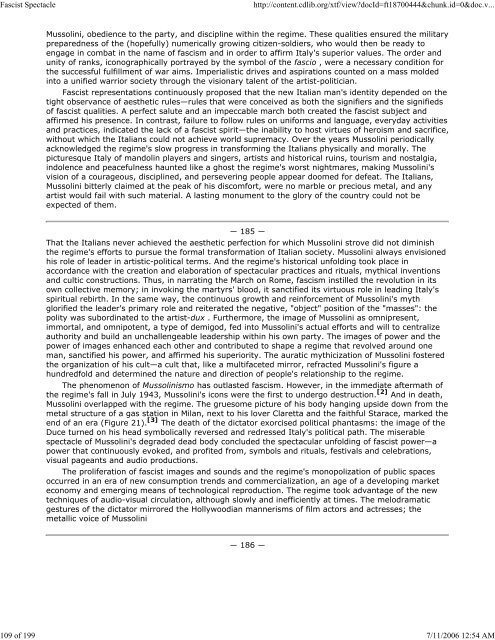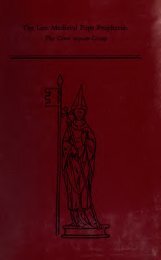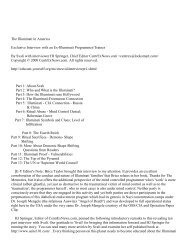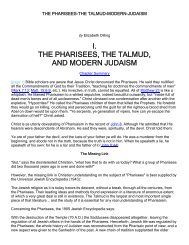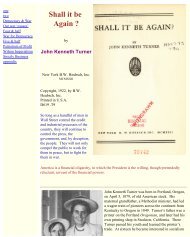Create successful ePaper yourself
Turn your PDF publications into a flip-book with our unique Google optimized e-Paper software.
<strong>Fascist</strong> <strong>Spectacle</strong> http://content.cdlib.org/xtf/view?docId=ft18700444&chunk.id=0&doc.v...<br />
Mussolini, obedience to the party, and discipline within the regime. These qualities ensured the military<br />
preparedness of the (hopefully) numerically growing citizen-soldiers, who would then be ready to<br />
engage in combat in the name of fascism and in order to affirm Italy's superior values. The order and<br />
unity of ranks, iconographically portrayed by the symbol of the fascio , were a necessary condition for<br />
the successful fulfillment of war aims. Imperialistic drives and aspirations counted on a mass molded<br />
into a unified warrior society through the visionary talent of the artist-politician.<br />
<strong>Fascist</strong> representations continuously proposed that the new Italian man's identity depended on the<br />
tight observance of aesthetic rules—rules that were conceived as both the signifiers and the signifieds<br />
of fascist qualities. A perfect salute and an impeccable march both created the fascist subject and<br />
affirmed his presence. In contrast, failure to follow rules on uniforms and language, everyday activities<br />
and practices, indicated the lack of a fascist spirit—the inability to host virtues of heroism and sacrifice,<br />
without which the Italians could not achieve world supremacy. Over the years Mussolini periodically<br />
acknowledged the regime's slow progress in transforming the Italians physically and morally. The<br />
picturesque Italy of mandolin players and singers, artists and historical ruins, tourism and nostalgia,<br />
indolence and peacefulness haunted like a ghost the regime's worst nightmares, making Mussolini's<br />
vision of a courageous, disciplined, and persevering people appear doomed for defeat. The Italians,<br />
Mussolini bitterly claimed at the peak of his discomfort, were no marble or precious metal, and any<br />
artist would fail with such material. A lasting monument to the glory of the country could not be<br />
expected of them.<br />
― 185 ―<br />
That the Italians never achieved the aesthetic perfection for which Mussolini strove did not diminish<br />
the regime's efforts to pursue the formal transformation of Italian society. Mussolini always envisioned<br />
his role of leader in artistic-political terms. And the regime's historical unfolding took place in<br />
accordance with the creation and elaboration of spectacular practices and rituals, mythical inventions<br />
and cultic constructions. Thus, in narrating the March on Rome, fascism instilled the revolution in its<br />
own collective memory; in invoking the martyrs' blood, it sanctified its virtuous role in leading Italy's<br />
spiritual rebirth. In the same way, the continuous growth and reinforcement of Mussolini's myth<br />
glorified the leader's primary role and reiterated the negative, "object" position of the "masses": the<br />
polity was subordinated to the artist-dux . Furthermore, the image of Mussolini as omnipresent,<br />
immortal, and omnipotent, a type of demigod, fed into Mussolini's actual efforts and will to centralize<br />
authority and build an unchallengeable leadership within his own party. The images of power and the<br />
power of images enhanced each other and contributed to shape a regime that revolved around one<br />
man, sanctified his power, and affirmed his superiority. The auratic mythicization of Mussolini fostered<br />
the organization of his cult—a cult that, like a multifaceted mirror, refracted Mussolini's figure a<br />
hundredfold and determined the nature and direction of people's relationship to the regime.<br />
The phenomenon of Mussolinismo has outlasted fascism. However, in the immediate aftermath of<br />
the regime's fall in July 1943, Mussolini's icons were the first to undergo destruction. [2] And in death,<br />
Mussolini overlapped with the regime. The gruesome picture of his body hanging upside down from the<br />
metal structure of a gas station in Milan, next to his lover Claretta and the faithful Starace, marked the<br />
end of an era (Figure 21). [3] The death of the dictator exorcised political phantasms: the image of the<br />
Duce turned on his head symbolically reversed and redressed Italy's political path. The miserable<br />
spectacle of Mussolini's degraded dead body concluded the spectacular unfolding of fascist power—a<br />
power that continuously evoked, and profited from, symbols and rituals, festivals and celebrations,<br />
visual pageants and audio productions.<br />
The proliferation of fascist images and sounds and the regime's monopolization of public spaces<br />
occurred in an era of new consumption trends and commercialization, an age of a developing market<br />
economy and emerging means of technological reproduction. The regime took advantage of the new<br />
techniques of audio-visual circulation, although slowly and inefficiently at times. The melodramatic<br />
gestures of the dictator mirrored the Hollywoodian mannerisms of film actors and actresses; the<br />
metallic voice of Mussolini<br />
― 186 ―<br />
109 of 199 7/11/2006 12:54 AM


